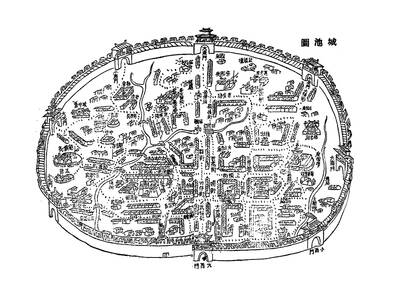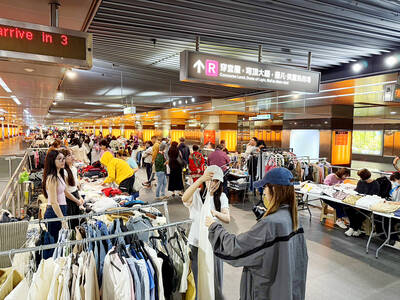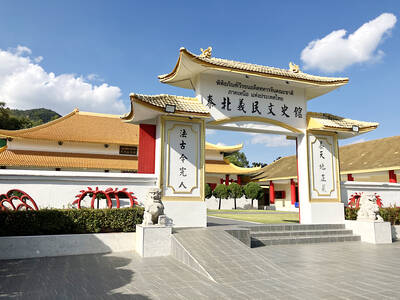Nearly a century has passed since the birth of futurism. Loudly proclaimed in Paris in 1909, the Futurist Manifesto -- drawn up by Italian poet Filippo Tommaso Marinetti and artist Giacomo Balla, among others -- valued the dynamism and violence of modern machinery -- such as automobiles -- while spurning everything associated with tradition and the past.
As automobiles are hardly considered the epitome of speed nowadays, it's probably time that futurism receive a critical re-examination. In The Futurist's Cookbook (未來主義者的食譜) named after Marinetti's 1932 book, Riverbed Theater (河床劇團) does just that. The play is the first of the group's series entitled "Research of Avant-garde Theories of the 20th Century."
In Cookbook, the questions Marinetti posed about Italian dining traditions and conventional ideas of food and eating are presented with ironic twists in the 45-minute performance.
"Just as the futurists challenged culinary traditions in their time, we now challenge the futurists. We consider the traditional to be of of no less value than futurism," said Craig Quintero, writer and director of The Futurist's Cookbook.
Is the sweat from the armpit of a dancer a delicacy? Is gulping watermelon the same as wolfing down human brains? Is vomiting as satisfying as eating? The performance, involving many stomach-churning scenes, asks the audience questions like these again and again.
Though not for the faint-hearted, the show is greatly enjoyable for its spontaneity and sharp humor. The cast may be one of the best in Taiwan's alternative theater, and their performances here are brilliant.
True to the group's principle of "total theater," characterized by richness in all elements from sound to bodily movement, the show demands the attention of all your senses.
The Futurist's Cookbook will be
performed at the old plum winery (烏梅酒廠) at Huashan Arts District, located at 1 Pate Rd., Sec. 1, Taipei (台北市八德路1段1號), at 7:30pm tomorrow, Sunday, and from Feb. 25 through Feb. 28. NT$350 admission includes drinks and snacks. Tickets (there are 30 for each show) are available through Acer ticketing outlets. Admission is restricted to audiences aged 16 or older.

May 26 to June 1 When the Qing Dynasty first took control over many parts of Taiwan in 1684, it roughly continued the Kingdom of Tungning’s administrative borders (see below), setting up one prefecture and three counties. The actual area of control covered today’s Chiayi, Tainan and Kaohsiung. The administrative center was in Taiwan Prefecture, in today’s Tainan. But as Han settlement expanded and due to rebellions and other international incidents, the administrative units became more complex. By the time Taiwan became a province of the Qing in 1887, there were three prefectures, eleven counties, three subprefectures and one directly-administered prefecture, with

It’s an enormous dome of colorful glass, something between the Sistine Chapel and a Marc Chagall fresco. And yet, it’s just a subway station. Formosa Boulevard is the heart of Kaohsiung’s mass transit system. In metro terms, it’s modest: the only transfer station in a network with just two lines. But it’s a landmark nonetheless: a civic space that serves as much more than a point of transit. On a hot Sunday, the corridors and vast halls are filled with a market selling everything from second-hand clothes to toys and house decorations. It’s just one of the many events the station hosts,

Among Thailand’s Chinese Nationalist Party (KMT) villages, a certain rivalry exists between Arunothai, the largest of these villages, and Mae Salong, which is currently the most prosperous. Historically, the rivalry stems from a split in KMT military factions in the early 1960s, which divided command and opium territories after Chiang Kai-shek (蔣介石) cut off open support in 1961 due to international pressure (see part two, “The KMT opium lords of the Golden Triangle,” on May 20). But today this rivalry manifests as a different kind of split, with Arunothai leading a pro-China faction and Mae Salong staunchly aligned to Taiwan.

Two moves show Taichung Mayor Lu Shiow-yen (盧秀燕) is gunning for Chinese Nationalist Party (KMT) party chair and the 2028 presidential election. Technically, these are not yet “officially” official, but by the rules of Taiwan politics, she is now on the dance floor. Earlier this month Lu confirmed in an interview in Japan’s Nikkei that she was considering running for KMT chair. This is not new news, but according to reports from her camp she previously was still considering the case for and against running. By choosing a respected, international news outlet, she declared it to the world. While the outside world